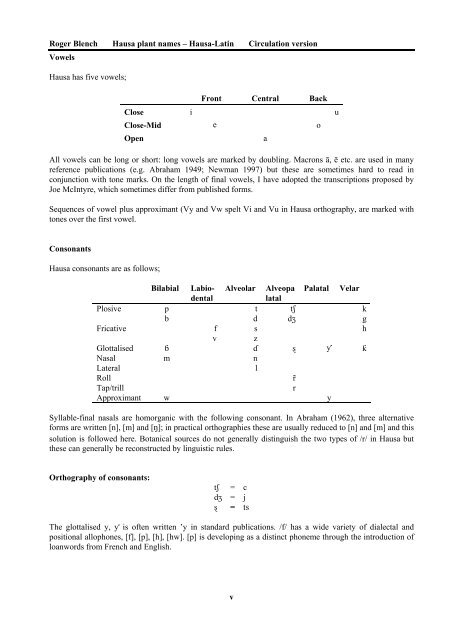HAUSA NAMES FOR PLANTS AND TREES - Roger Blench
HAUSA NAMES FOR PLANTS AND TREES - Roger Blench
HAUSA NAMES FOR PLANTS AND TREES - Roger Blench
You also want an ePaper? Increase the reach of your titles
YUMPU automatically turns print PDFs into web optimized ePapers that Google loves.
<strong>Roger</strong> <strong>Blench</strong> Hausa plant names – Hausa-Latin Circulation version<br />
Vowels<br />
Hausa has five vowels;<br />
Front Central Back<br />
Close i u<br />
Close-Mid e o<br />
Open<br />
a<br />
All vowels can be long or short: long vowels are marked by doubling. Macrons ā, ē etc. are used in many<br />
reference publications (e.g. Abraham 1949; Newman 1997) but these are sometimes hard to read in<br />
conjunction with tone marks. On the length of final vowels, I have adopted the transcriptions proposed by<br />
Joe McIntyre, which sometimes differ from published forms.<br />
Sequences of vowel plus approximant (Vy and Vw spelt Vi and Vu in Hausa orthography, are marked with<br />
tones over the first vowel.<br />
Consonants<br />
Hausa consonants are as follows;<br />
Bilabial<br />
Labiodental<br />
Alveolar<br />
Alveopa<br />
latal<br />
tS<br />
dʒ<br />
Palatal<br />
Velar<br />
Plosive<br />
p<br />
b<br />
t<br />
d<br />
k<br />
g<br />
Fricative<br />
f s<br />
h<br />
v z<br />
Glottalised ɓ ɗ ȿ ƴ ƙ<br />
Nasal m n<br />
Lateral l<br />
Roll r<br />
Tap/trill r<br />
Approximant w y<br />
Syllable-final nasals are homorganic with the following consonant. In Abraham (1962), three alternative<br />
forms are written [n], [m] and [N]; in practical orthographies these are usually reduced to [n] and [m] and this<br />
solution is followed here. Botanical sources do not generally distinguish the two types of /r/ in Hausa but<br />
these can generally be reconstructed by linguistic rules.<br />
Orthography of consonants:<br />
tʃ = c<br />
dʒ = j<br />
ȿ = ts<br />
The glottalised y, ƴ is often written ’y in standard publications. /f/ has a wide variety of dialectal and<br />
positional allophones, [f], [p], [h], [hw]. [p] is developing as a distinct phoneme through the introduction of<br />
loanwords from French and English.<br />
v

















